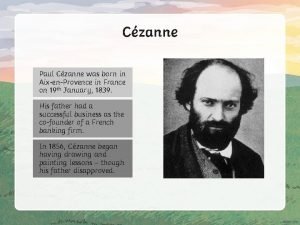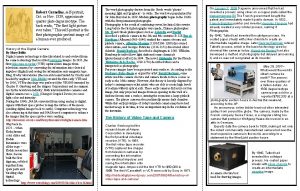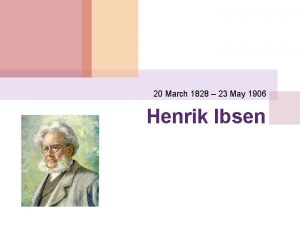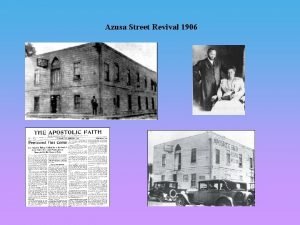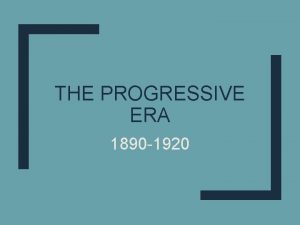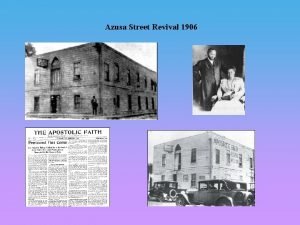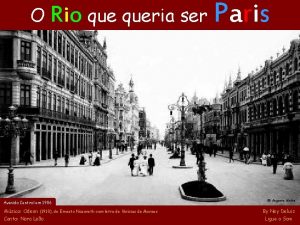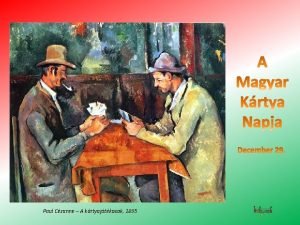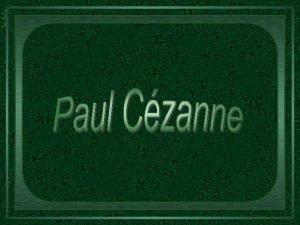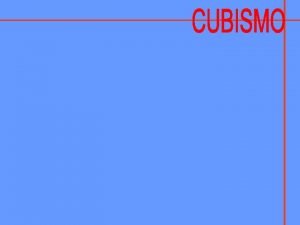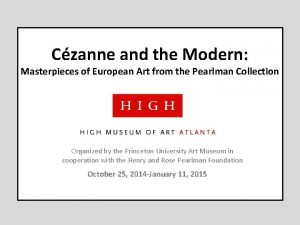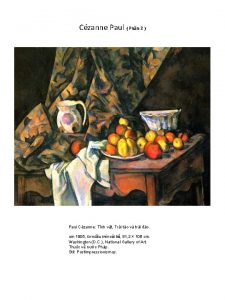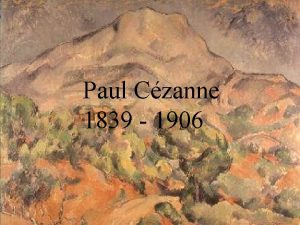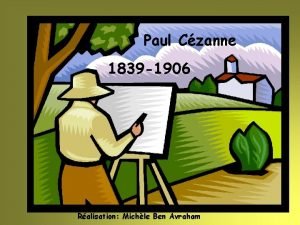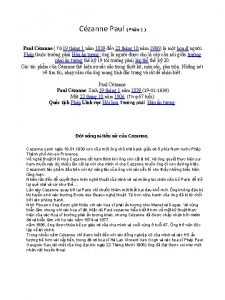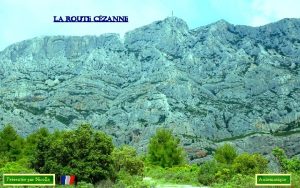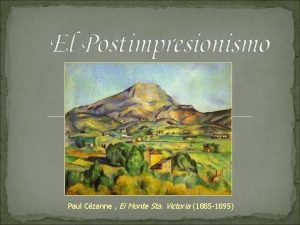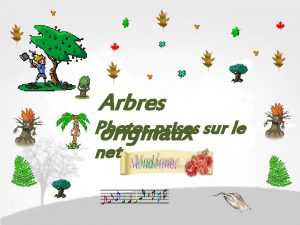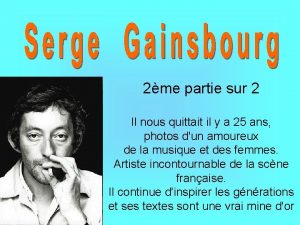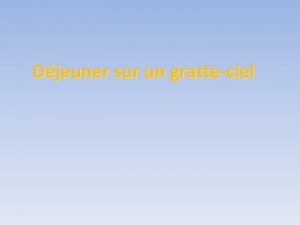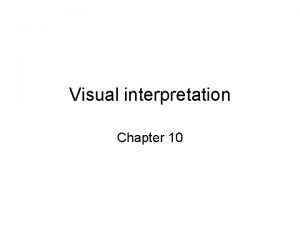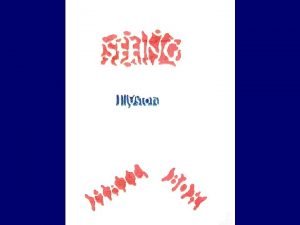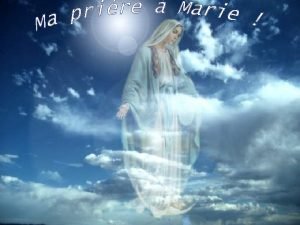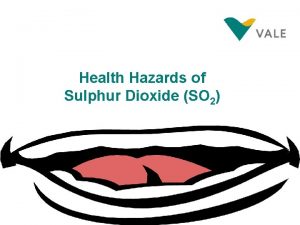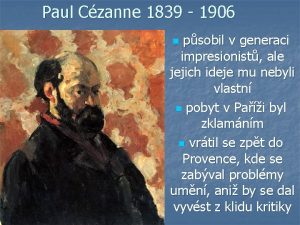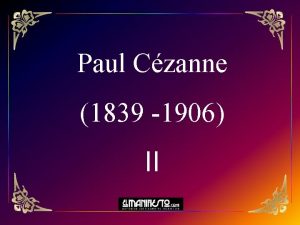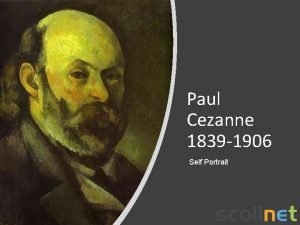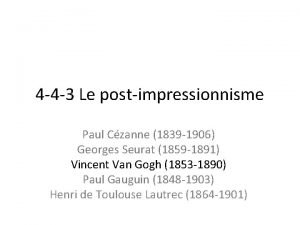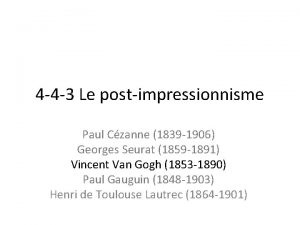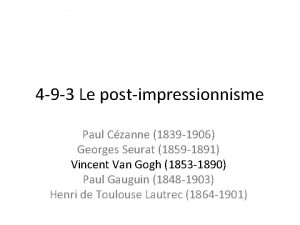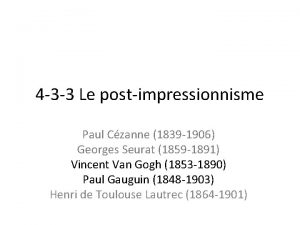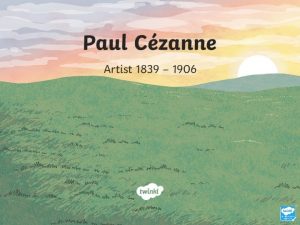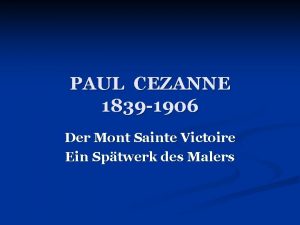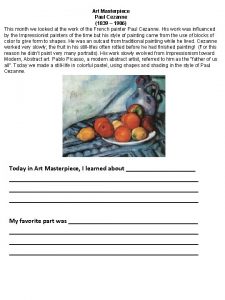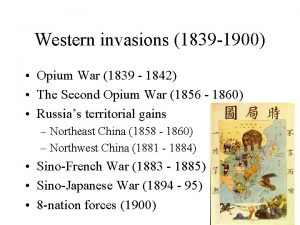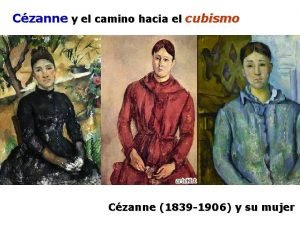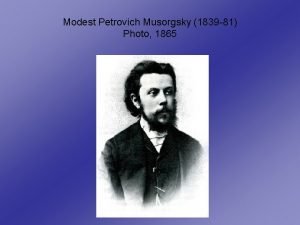Paul Czanne 1839 1906 Photo of Paul Czanne























































- Slides: 55

Paul Cézanne 1839 - 1906

Photo of Paul Cézanne in front of The Bathers.

Artistic Purpose • To convey the message that his pictures were flat, painted canvases, not imitations of reality. • To paint nature convincingly so as to reveal its basic structures and their relationships in space: “Interpret nature in terms of the cylinder, the sphere, the cone…”.

Artistic Credo • A painting is an artistic composition separate from reality—a creation rather than a reproduction. • Creation must be based on the contemplation of nature. • For the sake of composition, objects are distorted, reduced into basic geometrical shapes, and presented from multiple points of view.

Portraits • The sitter is not portrayed as an individual nor within the context of social criticism. • The human head, like an apple, can be seen as nothing more than a convenient geometric starting point for a composition in which every element was treated with equal respect and attention.

Paul Cézanne. Portrait of Madame Cézanne in the Greenhouse (ca. 1890). Oil on canvas.

Paul Cézanne. Portrait of Madame Cézanne in a Yellow Chair (1888 -90). Oil on canvas.

Cézanne’s wife Marie-Hortense photographed in 1900 at the age of 50.

Still Lifes: A Challenge in the Investigation of Visual Perception • A means of creating a new reality: making observers aware that what they were looking at was an image on a two-dimensional canvas • A means of achieving a canvas that could be appreciated for itself as a solidly composed structure of forms and colors • A means of expressing multiple points of view simultaneously

Paul Cézanne. Still Life: Basket of Apples (1880 -90). Oil on canvas.

Paul Cézanne. Still Life with Apples and Oranges (1895 -1900). Oil on canvas.

Paul Cézanne. Still Life with Vase of Flowers and Apples (1889 -1890). Oil on canvas.

Paul Cézanne. Still Life with Basket of Fruit (1888 -90). Oil on canvas.

Multiple Points of View

Paul Cézanne. Still Life with Dresser (1883 -1887). Oil on canvas.

Landscapes—Mont Sainte-Victoire • Exercises in painting the mountain from different points of view • Exercises in neutralizing the effects of perspective in favor of a unified picture space: developing an independent harmonious composition in “harmony in parallel with nature” • Exercises in editing • Exercises in expressing nature as architecture

The landscape round Aix-en-Provence with the Mont Sainte Victoire.

Mont Sainte-Victoire Ready for a day’s work

Paul Cézanne. Mont Sainte-Victoire from the Chemin de Velcros (1879). Oil on canvas.

Paul Cézanne. Mont Sainte-Victoire from Bellevue (1882 -85). Oil on canvas.

Abandons Linear Perspective • Perspective is not achieved through lines of sight converging on a common vanishing point. • Isolated diagonals and verticals, in the form of paths, aqueducts, or towering pine trees cut through the compositions to give the impression of depth • Passage (overlapping planes of color) create the impression of depth

Overlapping Planes: Passage The surface of the image is composed of horizontal areas of color set side by side and interlinking the separate spatial fields. Progressing through one spatial field after another, the alternating brown and green areas provide a sense of depth.

Paul Cézanne. Mont Sainte-Victoire (1885 -87). Oil on canvas.

Paul Cézanne. Mont Sainte-Victoire from the Large Pine (1885 -87). Oil on canvas.

Paul Cézanne. Mont Sainte-Victoire (1889). Oil on canvas.

Photograph of the site

Photograph of the site

Paul Cézanne. Road Near Mont Sainte-Victoire (1900). Oil on canvas.

Photograph of the site

Paul Cézanne. Bibémus: The Red Rock (1897 -98). Oil on canvas.

Paul Cézanne. Quarry and Mont Sainte-Victoire from Bibémus (1897). Oil on canvas.

Detail of Quarry and Mont Sainte-Victoire from Bibémus (1897).

Photograph of the site



View of the quarry

Cézanne’s Compositional Methods • • Size Central axis Color Form

This illustration shows that Cézanne has more than doubled the size of the mountain.

This is an illustration of the principle of organization so Often used by Cézanne: planes and volumes moving around an imaginary central axis.

The orange and green shapes are here reduced to two -dimensional patterns emphasizing how Cézanne interlocks and interweaves the pictorial surface.

The mass of the mountain is shown here in combination with the small white shapes to which it is related. Without these small shapes the mountain would be isolated. Here the two are interrelated through distribution and repetition.

Paul Cézanne. Bibémus Quarry (1895). Oil on canvas.

Paul Cézanne. Bibémus Quarry (1898). Oil on canvas.

Paul Cézanne. Mountains in Provence (ca. 1890). Oil on canvas.

Paul Cézanne. Mont Sainte-Victoire and the Chateau Noir (1904 -06). Oil on canvas.

Two views of the Chateau Noir with the Mont Sainte-Victoire in the background

Photograph of the site from Lauves.

Paul Cézanne. Mont Sainte Victoire (1902 -04). Oil on canvas.

Paul Cézanne. Mont Sainte-Victoire from Les Lauves (1904 -06). Oil on canvas.

Paul Cézanne. Mont Sainte-Victoire Seen from Lauves (1902 -04). Oil on canvas.

The Bathers • • Exercises in painting figures in landscapes Settings and figures have equal emphasis Integration of style and subject Multiple points of view

Paul Cézanne. Great Bathers (1894 -1905). Oil on canvas.

Paul Cézanne. Les Grandes Baigneuses (1900 -05). Oil on canvas.

Paul Cézanne. Great Bathers (1894 -1905). Oil on canvas.

Cézanne’s studio
 Czanne
Czanne 1834-1839
1834-1839 Robert cornelius self portrait
Robert cornelius self portrait 5 testu iruzkina
5 testu iruzkina All india muslim league 1906
All india muslim league 1906 May 23 1906
May 23 1906 Simla deputation 1906
Simla deputation 1906 Topeka kansas revival
Topeka kansas revival Atlanta race riot of 1906
Atlanta race riot of 1906 San francisco earthquake 1906 magnitude
San francisco earthquake 1906 magnitude Alpha phi alpha crest meaning
Alpha phi alpha crest meaning All india muslim league 1906
All india muslim league 1906 Charles parham
Charles parham Como era a avenida central após as reformas de 1906?
Como era a avenida central após as reformas de 1906? Czanne
Czanne Czanne
Czanne Dove nasce cezanne
Dove nasce cezanne Els jugadors de cartes
Els jugadors de cartes Cubismo
Cubismo Courtesan van gogh
Courtesan van gogh Czanne
Czanne Czanne
Czanne Czanne
Czanne Czanne
Czanne Czanne
Czanne Czanne
Czanne Czanne
Czanne Photo d'arbres originaux
Photo d'arbres originaux This photo by unknown author is licensed under cc by-nc
This photo by unknown author is licensed under cc by-nc Stade de tanner fille
Stade de tanner fille Photo
Photo Image search
Image search Marcel ginsburg
Marcel ginsburg Djeuner
Djeuner Vysychání olejů
Vysychání olejů Visual interpretation
Visual interpretation Translate photo
Translate photo Find the same photo
Find the same photo Photo of sulphur
Photo of sulphur Search by image
Search by image Translate words
Translate words Insert photo here
Insert photo here Photo resist
Photo resist Two vaginas
Two vaginas Photo subject
Photo subject Work in pairs
Work in pairs à ceux que j'aime et qui m'aiment
à ceux que j'aime et qui m'aiment Photo
Photo Photo location
Photo location Eeg for dummies
Eeg for dummies Locr gps photo
Locr gps photo Photo of sulphur
Photo of sulphur Tlc59581
Tlc59581 Extended caption
Extended caption Kamat photo flash
Kamat photo flash Solve reasoning questions by photo
Solve reasoning questions by photo
